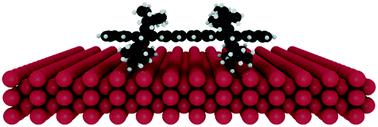当前位置:
X-MOL 学术
›
Mol. Syst. Des. Eng.
›
论文详情
Our official English website, www.x-mol.net, welcomes your
feedback! (Note: you will need to create a separate account there.)
Modeling diffusion of nanocars on a Cu (110) surface
Molecular Systems Design & Engineering ( IF 3.2 ) Pub Date : 2020-02-24 , DOI: 10.1039/c9me00171a Kutay B. Sezginel 1, 2, 3, 4 , Christopher E. Wilmer 1, 2, 3, 4, 5
Molecular Systems Design & Engineering ( IF 3.2 ) Pub Date : 2020-02-24 , DOI: 10.1039/c9me00171a Kutay B. Sezginel 1, 2, 3, 4 , Christopher E. Wilmer 1, 2, 3, 4, 5
Affiliation

|
Nanoscale devices and machines that can be externally controlled or programmed promise revolutionary technological improvements. One example of such machines are nanocars, which are organic supramolecular structures (typically between 200–2000 Da) designed to achieve controlled molecular motion on atomically smooth surfaces. Spurred by a recent global competition where such nanocars had to race each other, interest in this nascent area has recently increased. However, the design space of nanocars is large, and a thorough understanding of how their structure affects their motion on surfaces is lacking. In this work, we investigated the diffusion of nine large organic molecules on a Cu (110) surface using classical simulation methods and transition state theory (TST). We find that, as expected, these molecules tended to diffuse more slowly as their molecular weight and attraction to the surface increases. However, these two parameters do not give a complete picture of surface diffusion. Thus we defined a structural parameter, elevation weighted density, based on the geometry of the molecule that interacts with the surface. We show that this parameter is a good predictor of surface diffusion, as demonstrated by its high rank correlation with TST free energy barriers and with diffusion coefficients calculated using classical simulations. We further discuss design strategies to tune the diffusion performance of nanocars.
中文翻译:

模拟纳米汽车在Cu(110)表面上的扩散
可以外部控制或编程的纳米级设备和机器有望带来革命性的技术改进。这种机器的一个例子是纳米汽车,它是有机超分子结构(通常在200–2000 Da之间),旨在在原子光滑表面上实现受控的分子运动。在最近的全球性竞赛中,这种纳米汽车必须相互竞争,这引起了人们的兴趣。然而,纳米汽车的设计空间很大,并且缺乏对它们的结构如何影响其在表面上的运动的透彻了解。在这项工作中,我们使用经典的模拟方法和过渡态理论(TST)研究了九种大有机分子在Cu(110)表面上的扩散。我们发现,正如预期的那样,这些分子的分子量和对表面的吸引力增加时,扩散速度往往会更慢。但是,这两个参数不能完全显示表面扩散。因此,我们根据与表面相互作用的分子的几何形状定义了结构参数,即高程加权密度。我们表明,该参数是表面扩散的良好预测器,正如它与TST自由能垒和使用经典模拟计算的扩散系数的高等级相关性所证明的那样。我们将进一步讨论设计策略,以调整纳米汽车的扩散性能。基于与表面相互作用的分子的几何形状。我们表明,该参数是表面扩散的良好预测器,正如它与TST自由能垒和使用经典模拟计算的扩散系数的高等级相关性所证明的那样。我们将进一步讨论设计策略,以调整纳米汽车的扩散性能。基于与表面相互作用的分子的几何形状。我们表明,该参数是表面扩散的良好预测器,正如它与TST自由能垒和使用经典模拟计算的扩散系数的高等级相关性所证明的那样。我们将进一步讨论设计策略,以调整纳米汽车的扩散性能。
更新日期:2020-02-24
中文翻译:

模拟纳米汽车在Cu(110)表面上的扩散
可以外部控制或编程的纳米级设备和机器有望带来革命性的技术改进。这种机器的一个例子是纳米汽车,它是有机超分子结构(通常在200–2000 Da之间),旨在在原子光滑表面上实现受控的分子运动。在最近的全球性竞赛中,这种纳米汽车必须相互竞争,这引起了人们的兴趣。然而,纳米汽车的设计空间很大,并且缺乏对它们的结构如何影响其在表面上的运动的透彻了解。在这项工作中,我们使用经典的模拟方法和过渡态理论(TST)研究了九种大有机分子在Cu(110)表面上的扩散。我们发现,正如预期的那样,这些分子的分子量和对表面的吸引力增加时,扩散速度往往会更慢。但是,这两个参数不能完全显示表面扩散。因此,我们根据与表面相互作用的分子的几何形状定义了结构参数,即高程加权密度。我们表明,该参数是表面扩散的良好预测器,正如它与TST自由能垒和使用经典模拟计算的扩散系数的高等级相关性所证明的那样。我们将进一步讨论设计策略,以调整纳米汽车的扩散性能。基于与表面相互作用的分子的几何形状。我们表明,该参数是表面扩散的良好预测器,正如它与TST自由能垒和使用经典模拟计算的扩散系数的高等级相关性所证明的那样。我们将进一步讨论设计策略,以调整纳米汽车的扩散性能。基于与表面相互作用的分子的几何形状。我们表明,该参数是表面扩散的良好预测器,正如它与TST自由能垒和使用经典模拟计算的扩散系数的高等级相关性所证明的那样。我们将进一步讨论设计策略,以调整纳米汽车的扩散性能。











































 京公网安备 11010802027423号
京公网安备 11010802027423号